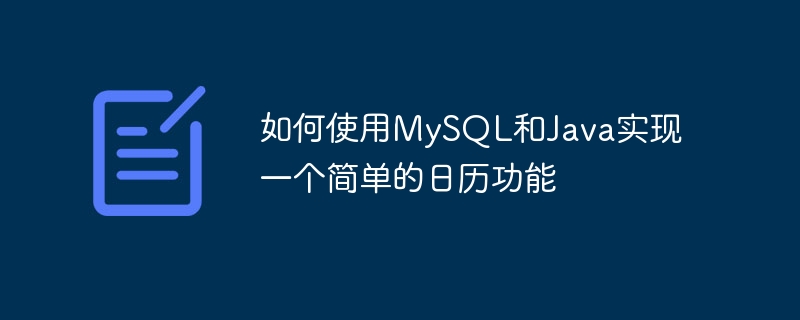

How to use MySQL and Java to implement a simple calendar function
In modern society, people often need to manage their schedules and daily affairs. A convenient and practical calendar function can not only help people manage time effectively, but also remind them of important events. This article will introduce how to use MySQL and Java to implement a simple calendar function and provide specific code examples.
First, we need to create a database to store calendar-related information. We can use MySQL to create a database named calendar and create a table named events to store events. The table can contain the following fields: id (unique identifier), title (event title), date (event date), and description (event description). We can use the following code to create this table:
CREATE DATABASE calendar; USE calendar; CREATE TABLE events ( id INT AUTO_INCREMENT PRIMARY KEY, title VARCHAR(255) NOT NULL, date DATE, description VARCHAR(255) );
Next, we need to write Java code to implement the calendar function. We will use Java's Swing library to create a simple user interface that allows users to add, edit, and delete events.
First, we create a Java class called CalendarApp to launch our application. In this class, we create a Swing window called MainFrame and set its title, size, and closing action. We'll also add a panel to the window called CalendarPanel to display the calendar, and a panel called EventPanel to display event details. Here is a code example for CalendarApp:
import javax.swing.JFrame;
public class CalendarApp {
public static void main(String[] args) {
JFrame frame = new MainFrame();
frame.setTitle("Calendar");
frame.setSize(800, 600);
frame.setDefaultCloseOperation(JFrame.EXIT_ON_CLOSE);
frame.setVisible(true);
}
}Next, we create a class called MainFrame, inherited from JFrame, to display the main window of our calendar application. In this class, we will set up the layout and most of the behavior of the calendar interface. The following is a code example for MainFrame:
import javax.swing.JFrame;
public class MainFrame extends JFrame {
private CalendarPanel calendarPanel;
private EventPanel eventPanel;
public MainFrame() {
calendarPanel = new CalendarPanel();
eventPanel = new EventPanel();
// 设置主窗口的布局
getContentPane().setLayout(new BorderLayout());
getContentPane().add(calendarPanel, BorderLayout.CENTER);
getContentPane().add(eventPanel, BorderLayout.EAST);
// TODO: 添加事件监听和其他行为
}
}Next, we create a class called CalendarPanel, inherited from JPanel, to display a calendar for one month. We need to use JLabel and JButton to display the date and corresponding action button. The following is a code example for CalendarPanel:
import javax.swing.JPanel;
public class CalendarPanel extends JPanel {
private JLabel monthLabel;
private JLabel[] dayLabels;
private JButton[] dateButtons;
public CalendarPanel() {
// 初始化月份标签
monthLabel = new JLabel();
// 初始化日期标签和按钮
dayLabels = new JLabel[7];
dateButtons = new JButton[42];
// 创建和添加标签和按钮
// TODO: 实现日历的绘制和操作
}
}Finally, we create a class called EventPanel, inherited from JPanel, to display event details for the selected date. We can use JTable to display the event list and use JTextField to edit the event title and description. The following is a code example for EventPanel:
import javax.swing.JPanel;
public class EventPanel extends JPanel {
private JTable eventTable;
private JTextField titleField;
private JTextField descriptionField;
public EventPanel() {
// 初始化事件列表和输入字段
eventTable = new JTable();
titleField = new JTextField();
descriptionField = new JTextField();
// 创建和添加组件
// TODO: 实现事件列表和输入字段的显示和操作
}
}The above are the steps and sample code for implementing a simple calendar function using MySQL and Java. By properly designing the database structure and using the Swing library to create the user interface, we can easily implement a simple but practical calendar application. Readers can further refine and customize this application according to their needs and preferences. I hope this article is helpful to readers, thank you!
The above is the detailed content of How to implement a simple calendar function using MySQL and Java. For more information, please follow other related articles on the PHP Chinese website!
